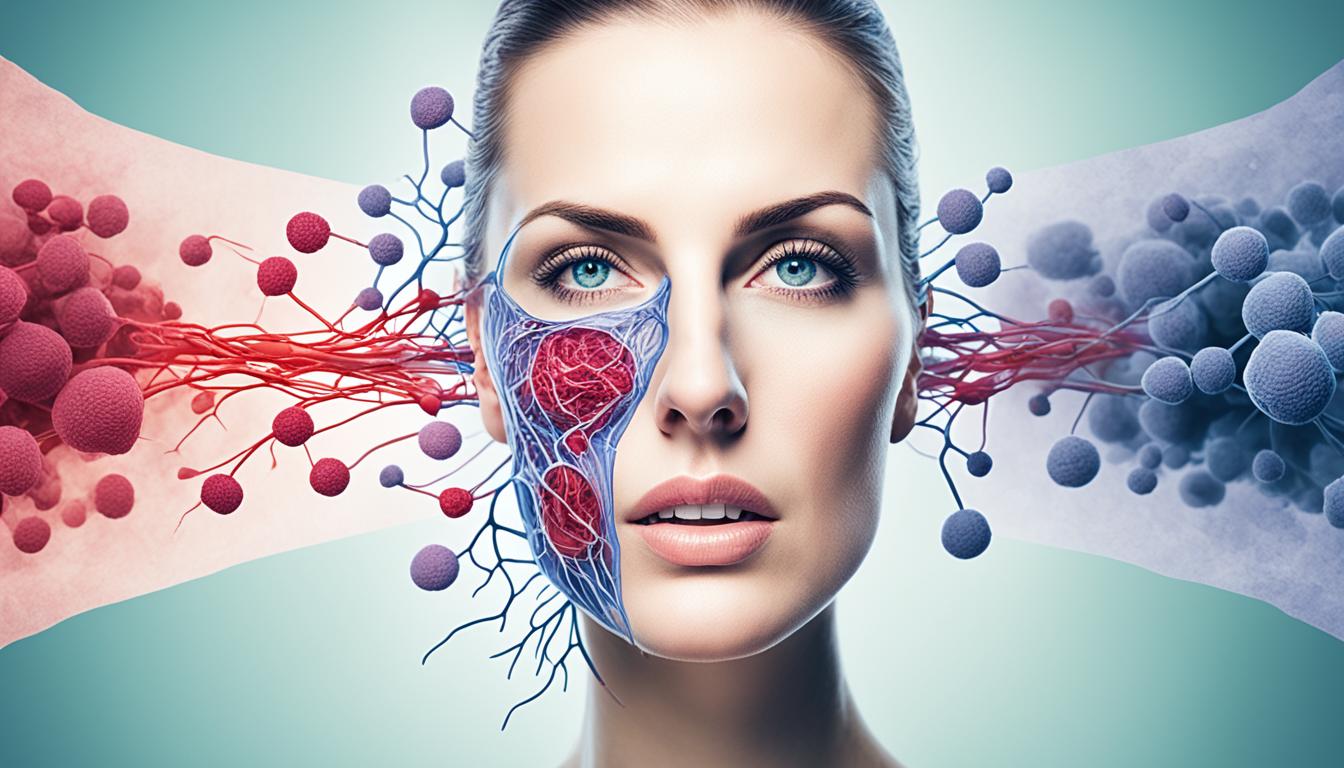Mononucleosis, known as the kissing disease, is caused by the Epstein-Barr virus (EBV). It spreads through saliva, like kissing or sharing utensils. Symptoms include feeling tired, a sore throat, swollen glands, fever, rash, and a large spleen.
Doctors diagnose mononucleosis by looking at medical history, doing a physical check, and blood tests. The goal is to find specific antibodies. For treatment, people with mono should rest, drink plenty of water, and take pain relievers. Researchers are looking into using stem cell therapy but more studies are needed to know if it really helps.
Key Takeaways:
- Mononucleosis, known as the kissing disease, comes from the Epstein-Barr virus.
- It spreads through saliva, like kissing or using the same utensils.
- Symptoms include being very tired, a sore throat, swollen glands, fever, rash, and a big spleen.
- To diagnose, doctors will review your history, check your body, and do blood tests.
- The main treatment is to rest, drink water, and use pain relievers you can buy at the store.
Causes and Transmission of Mononucleosis
Mononucleosis is often called the kissing disease. It’s caused by the Epstein-Barr virus (EBV). This virus mainly spreads through saliva, which is why kissing can pass it on. But it’s key to know that mononucleosis spreads in other ways too. This includes sharing utensils or glasses, and even through blood transfusions.
When someone is around the saliva or mucous of an infected person, they can get the virus too. This usually happens through sharing spoons or glasses. In some rare cases, blood transfusions can also transmit the virus.
The risk of getting infected by the EBV might vary by age group. Teens and young adults are more likely to catch it directly from another person. Children, however, can often get it from family members.
The time from catching the virus to when symptoms show up is about 6 weeks. People in this early stage may not feel sick but can still spread the virus. This is important to prevent more people from catching it.
Transmission Methods:
- Saliva (kissing or sharing utensils)
- Respiratory droplets (coughing or sneezing)
- Sharing utensils or drinking glasses
- Blood transfusions (rare cases)
Knowing how mono spreads can help us stop it from spreading. Doing things like washing your hands and not getting too close to sick people can lower the chance of getting mono. This simple advice can go a long way in keeping it at bay.
Symptoms and Diagnosis of Mononucleosis
Mononucleosis, known as the kissing disease, varies between people. Common signs are fatigue, a sore throat, and swollen glands. You may also have a fever, rash, and a bigger spleen. These signs look a lot like a cold or the flu.
It is crucial to spot less common signals. These include chest tightness, short breath, and a stiff neck. Other signs are yellow skin, nosebleeds, and heart fluttering.
Diagnosing mono involves learning your past, checking you, and tests. Your doctor will ask about your health and symptoms. They will look for signs like swollen glands and a big spleen.
The monospot test is key in diagnosing mono. It finds special antibodies that show mono is likely. A good result strongly suggests mono.
Doctors often also do a EBV antibody test. It looks for antibodies your body makes when fighting EBV. A positive result, with the right symptoms, helps confirm mono.
Spotting mono’s symptoms and getting a correct diagnosis are very important. If you have or think you might have mono, see a doctor. They can offer the best advice and care.
Stem Cell Therapy and Conclusion
Stem cell therapy shows hope in tackling mononucleosis, but we need more research. The main way to fight this illness now is by easing symptoms. This includes rest, drinking plenty of water, and using over-the-counter pain meds.
If you have mono, focus on rest and avoid hard activities that could make you feel worse. Always keep your hands clean to stop the virus from spreading. Think about seeing a doctor if you don’t get better or if you feel worse.
To wrap up, mononucleosis is common but can usually be handled with care and rest. Although stem cell therapy is promising, more work is needed to make treatments better. This will help patients more and give doctors new tools for the future.

